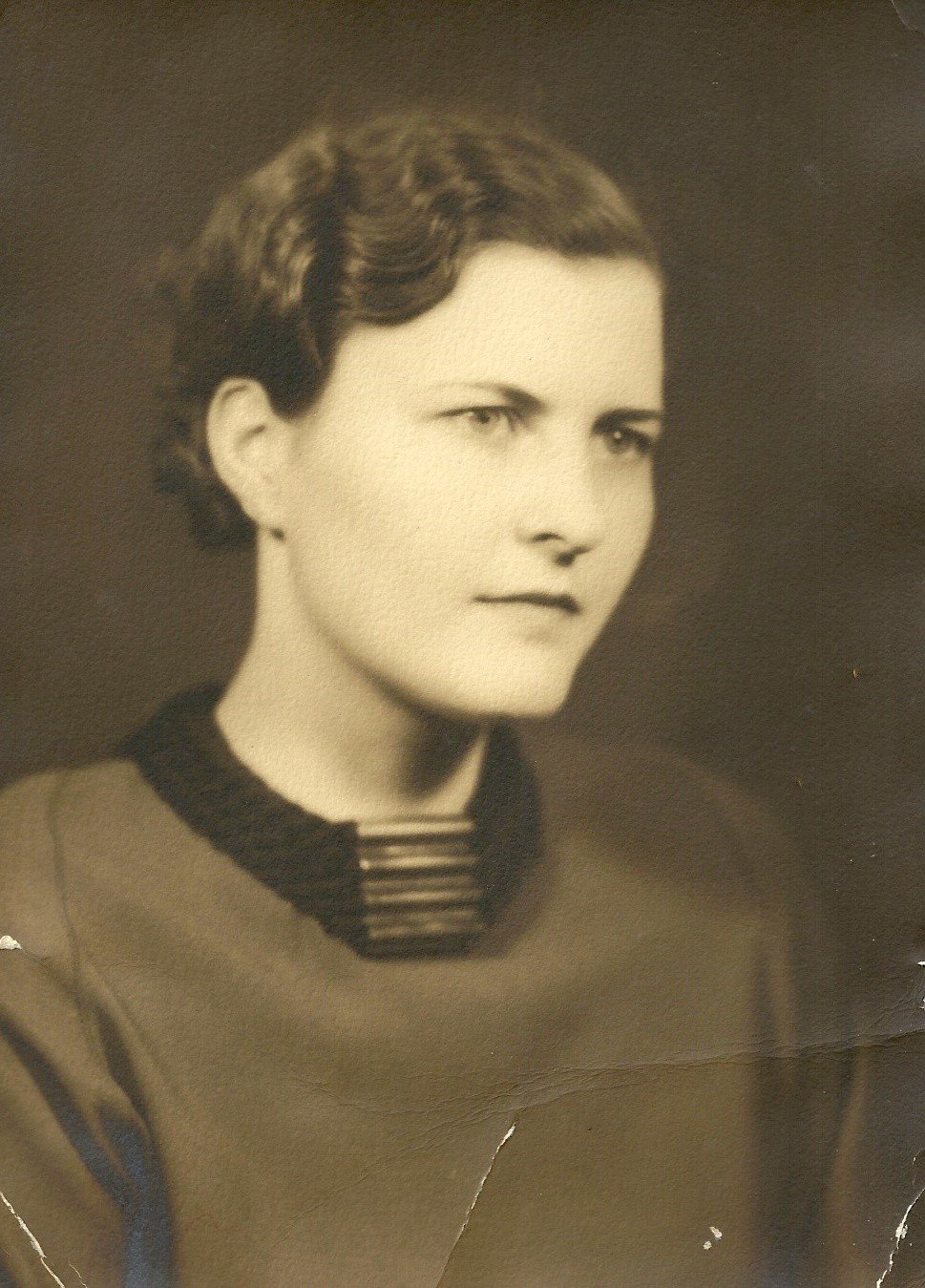She wasn’t waiting on an estranged husband in the bar of the Seelbach Hotel.
She didn’t receive word that said estranged husband died in a car accident on the way to meet her.
She didn’t throw herself down the elevator shaft in response.
She wasn’t found half-naked in a negligee and stockings.
No one heard her fall, and no one ran out in the hallway to catch Lt. Gov. Henry Denhardt stealing away.
She did fall at least six stories, and she died instantly, not hours later at the hospital. She was not penniless. She had a nice funeral, and she was buried in a quiet plot of her own. She was described as beautiful, sweet and well-liked. She was grieved by those who knew her.
She was a real person, and her name was Patricia Wilson.
On Thursday morning, July 16, 1936, a woman’s lifeless body was discovered atop a dummy elevator car at the Seelbach Hotel. She was soon identified as Wilson (born Pearl Mae Elliot), an unemployed divorcée who resided in a boarding house at 847 S. First St. When the cause of her death (murder? suicide?) could not be determined, a chain of events eventually led to an unresolved police investigation, and Patricia Wilson was largely forgotten... until 1987, when a Seelbach employee reported seeing a woman in a “blue” dress with long dark hair approaching him in the hallway. He watched as she walked up to — and through — the closed elevator doors.
They called her The Lady in Blue.
A resourceful Seelbach employee made the connection to Wilson after finding a 1936 newspaper article about her fall down the elevator shaft at the Seelbach. An accompanying photo showed a beautiful, dark-haired woman with fine features. Her hair is pulled back and pinned at the nape of her neck with finger waves surrounding her face.
It has been since the 1980s when Seelbach guests and staffers reported a sighting of The Lady in Blue.
More recently, guests have reported feeling cold spots and the lingering scent of her perfume, according to Larry Johnson, historian of The Seelbach Hilton and author of the book “The Seelbach: A Centennial Salute to Louisville’s Grand Hotel.”
This, however, does not deter ghost hunters from checking into the historic hotel in hopes of catching the famous spirit with electromagnetic field meters, full spectrum cameras and electronic voice phenomena recorders.
The internet offers many versions of Patricia’s tragic death at the hotel and reasons why her restless spirit remains there. The mainstays are that (1) she was waiting for her estranged husband at the Seelbach so that they might reconcile, but he died in a car accident on the way to the hotel. Patricia was distraught and threw herself down the elevator shaft, or (2) that Patricia may have been murdered by former Lt. Gov. Henry Denhardt.
So what really happened at the Seelbach on the evening of July 15, 1936?
Using sources such as city directories, probate court records, circuit court records, coroner’s inquest records and archived Courier Journal articles, I got a factual glimpse of Patricia’s brief life in Louisville.
‘I will be back later, Ma’
The Jefferson County Coroner’s inquest dated Aug. 7, 1936 details the events that unfolded on July 16, 1936. The first witness to testify was 18-year-old James Embry, a linen sorter at the Seelbach Hotel. At 7:30 a.m. he was on the first floor dealing with a coating of dust and pieces of plaster that had fallen inside the linen car. The linen elevator or dummy elevator was smaller than the average elevator car and contained a single shelf. Its sole purpose was to transport fresh linens to the upper floors from the laundry. Dirty linens, in turn, were stripped from the rooms and tossed down a chute to the laundry room. While trying to find the source of the debris inside the elevator, James glanced up and saw a woman’s glove sticking out from the top edge of the car. He pulled out the glove, and then saw the corner of a woman’s pocketbook. James described to the coroner’s jury how he went to the second floor and pulled open the elevator door to find the lifeless young woman atop the car. He called for Dell Burton, a chambermaid, who testified that Patricia was fully dressed in an “orchid” colored dress with white high heels. Coroner John M. Keaney was contacted by the hotel manager and his examination determined that Patricia had died in the early hours of the morning of July 16, 1936, having sustained a fractured skull, fractured left leg and fractures to the right tibia and fibula. Her remains were removed from the hotel to L.D. Bax Funeral Home.Patricia Wilson’s body was identified by Mary Katherine “Katie” Berlew, her landlady. Katie was enthusiastic and informative in interviews. She told police and reporters that Patricia and her husband moved to Louisville in 1932 from Oklahoma. The couple lived on and off at rooming houses operated by Mrs. Berlew and her husband Charles. On July 15, Katie spoke with Patricia as she was leaving the house. Patricia called out, “I will be back later, Ma,” as she left carrying her gloves, purse and her hat. Following Patricia’s death, her hat was found in the hotel bar, then called “The Stables”. There is no documentation of her movements at the hotel between the time she left The Stables and the discovery of her body in the elevator the next morning.
Cost of death
In the days following Patricia’s death, a Prudential life insurance policy surfaced in the amount of $500 and an accidental death benefit, also $500.00. Patricia’s sister, Ruby Miller, gave her consent to Louisville attorney Edward G. Langan to be appointed administrator of the estate. Ruby resided in Cushing, Oklahoma, and was not able to travel to Louisville.With the estate open, Katie Berlew quickly filed a claim for $350. She stated that she had loaned Patricia the amount of $100 “for the divorce and the trip to Indianapolis” and that Patricia had not paid room and board to Mrs. Berlew in over a year. Berlew’s testimony was corroborated by a witness, Lena Richardson.
L.D. Bax & Sons Funeral Home at 719 E. Chestnut St. handled the arrangements for the funeral with a casket costing $150, plus expenses for a box, removal of the body to the funeral home, embalming, a hearse, a plot at Evergreen Cemetery and a burial dress. The total amount spent on the funeral was $247. After the other costs associated with Patricia’s death (including a coroner’s inquest fee, medical examiner fees, administrator’s fees, bond and court costs) were paid, Katie Berlew received $280 for her claim against the estate. Langan finalized the distribution of assets from the estate without purchasing a monument to mark Patricia’s grave. Patricia’s sister Ruby received no disbursement from the estate.
meeting of reconciliation?
In newspaper accounts, Katie Berlew described Patricia Wilson as “happy and carefree.” In articles appearing in the Courier Journal, it was reported that Patricia and her husband, L.B. Wilson, had separated, but that he had visited Patricia about six weeks prior to her death. The article identified Patricia’s husband as a “traveling salesman for an auto parts outfit.” This brief mention of Patricia’s husband and their estrangement seems to be the sole basis for the urban legend that she was meeting her husband that night at the Seelbach to reconcile, but that he died in a car accident on the way. The purported meeting is not of record in any court documents, nor is the husband ever mentioned in any newspaper article again. Patricia’s Kentucky death certificate indicates that Patricia was divorced at the time of her death. As part of her claim against Patricia’s estate, Katie Berlew testified that she had loaned money to Patricia for her divorce. No surviving spouse ever came forward to claim his share of Patricia’s estate.
First lawsuit
Langan filed a wrongful death suit on behalf of the estate of Patricia Wilson against the Seelbach on Nov. 9, 1936. In his complaint, Langan stated that the Seelbach advertised extensively, inviting the public to visit the Derby Bar and the Stables for lunch, dinner and specialty cocktails. As such, it was not unusual for people not registered as guests to be on the premises.Langan alleged that while patronizing the restaurant or bars, Patricia Wilson may have mistaken the door to the dummy elevator for a washroom door. He described the doors as follows: “said ‘dummy’ elevator door had the appearance of a restroom or washroom door with a large piece of glazed wire glass in the middle thereof, that said dummy elevator door opens on hinges as an ordinary restroom door, that it has a knob like a door to any ordinary room and opens the same way and that it is unlike the ordinary elevator door and has not that appearance.” The doors to the ‘dummy’ or service elevator were supposed to be kept locked and were not supposed to open if the elevator was not at the particular floor. Langan stated that by the hotel’s own negligence, the hotel “allowed the said lock on said door, with the general appearance of a washroom, to be broken and out of repair and was the direct and proximate cause” of Patricia’s fall to her death.
He asked for $25,000 in damages for the hotel’s negligence.
During the Coroner’s inquest earlier in August 1936, Seelbach employees had been asked to describe the manner in which the linen elevator typically operated. James Embry described how the door to the elevator had a “special lock” that would release only if the elevator was at the floor. Assistant Manager E.L. Stoll was shown photos of the elevator door on the seventh floor. The estate’s attorney, James Robertson, asked if Stoll was present when the photos were taken. Under oath, Stoll responded that he was present, along with Seelbach attorney Joseph Everhart, and an electrician, Oscar Weber. Stoll denied that he had knowledge about the switch pictured on the door, whether the switch was faulty or if he was aware that the seventh-floor elevator door opened quite easily without the elevator car being present. After hearing testimony from five hotel employees who, basically, believed that Patricia had made a mistake looking for a washroom, the inquest jury had concluded that Patricia Wilson died by her own negligence.
The hotel’s answer to the civil complaint brought by Edward Langan contained a broad denial of all of Langan’s allegations and stated that Patricia Wilson was not a registered guest, rather that she was a trespasser, and there was no duty owed her as such, that there were no witnesses to the incident, that she was negligent, and that Langan’s suit was based on “surmise, guess-work and theory, and theory based upon theory.”
The suit was subsequently dismissed.
Prominent politician
Almost one year later, Langan and co-council James Robertson (attorney for the estate during the Coroner’s inquest) filed a second civil suit on behalf of the estate of Patricia Wilson, this time accusing former Brigadier Gen. Henry H. Denhardt of having “assaulted, beat and bruised said Patricia Wilson with force and violence, and malicious acts causing the death of Patricia Wilson and causing her to fall down an elevator shaft in said hotel” and as a result of his actions, was the cause of her death.This time, Langan asked for damages in the amount of $75,000.
Denhardt was an influential Kentucky politician and retired U.S. Army officer who had served as lieutenant governor from 1923 to 1927. Denhardt, by all reports a colorful figure, was already in the news, having just been charged with the murder of his fiancé, society figure Verna Garr Taylor. The jury voted 7 to 5 in favor of acquittal in his first trial. Denhardt was awaiting retrial in July, 1937, when Langan’s suit was filed against him.
There was no proof to substantiate the claims in the lawsuit at the time it was filed. When asked about the basis of his suit, Robertson told the Courier Journal that a client asserted to him that Denhardt was involved in Patricia Wilson’s death. Robertson stated that he did nothing about it, and then another friend told him the same thing. Robertson admitted that he thought it was just people “trying to blame a man charged with one crime,” but that the rumors became so strong that he felt he could no longer ignore it. Robertson told the newspapers that he had hoped that the filing could be delayed until the matter was completely investigated, but that the statute of limitations was about to run out.
Truth went to the grave
Denhardt was incredulous at being served with such a suit. On July 28, 1937, Denhardt, who lived in Bowling Green, filed a counter-suit against Langan and James Robertson in Warren County Circuit Court. In his complaint, Denhardt’s attorney slammed Langan and Robertson, alleging they acted improperly in filing the suit. Denhardt stated that his enemies were intent upon destroying him in all aspects of his life, including “financially, politically and socially.” He referenced rumors that had circulated in Henry County prior to his first murder trial that Denhardt had killed “his former wife, eight other women and fifteen to twenty men.” Denhardt stated that the rumors were intended to create public hostility toward him in the pendency of his second trial. Denhardt was adamant that he was not at the Seelbach and he did not know Patricia Wilson. His suit sought damages in the amount of $150,000.Denhardt was released on bond while awaiting retrial in the Verna Garr Taylor case when he was shot and killed by E.S., Jack and Roy Garr (Verna’s brothers) in Shelbyville on Sept. 20, 1937, the night before the retrial began.
Upon Denhardt’s death, the Wilson case was once again retired.
Meet Pearl Elliot
Billie Loffland remembers her mother Ruby Faye Elliott mentioning a sister who had died in an accident. But Billie was a child at the time, and her mother never brought it up again. She was only a little surprised to get a call from a stranger in Louisville, Kentucky, asking about the aunt she never met. She agreed to let me visit her in Wichita, Kansas, after reviewing the newspaper clippings that I had sent her about the 1936 death of Patricia Wilson and the subsequent lawsuits filed by Patricia’s estate in 1936 and 1937. Before my visit, Billie discussed the matter with her brother, and each retrieved suitcases from their attics. These suitcases, curated by their mother, contained newspaper clippings, documents and family photos. Among the photos in the suitcase was the original photo of Patricia Wilson, which had been published in the Courier Journal on July 16, 1936. Written in script on the back of the picture is the name “Pearl Mae Elliott”, or as we know her here in Louisville, “Patricia Wilson, The Lady in Blue”.Billie’s mother, Ruby Faye Elliott was born in Davenport, Oklahoma, in 1915, the youngest of four children of Albert and Annie Elliott. The two Elliott girls were named for jewels: Ruby and Pearl. Their oldest sibling, Frank “Frankie” Lee Elliott, was born in 1905. Pearl Mae “Pearlie” Elliott was born on March 10, 1910. Next in line was John “Jack” Elliott, born in 1913 and lastly, Ruby Faye Elliott in 1915.
The four Elliott children were photographed together in 1918. Pearl wears a dark colored dress with an embroidered collar. She and sister Ruby both have their hair cut in short bobs, and Pearl levels a steady gaze beneath a neat row of bangs. A black and gold funeral card in the suitcase revealed that their father, Albert Elliot died in 1915, just months before Ruby’s birth.
Annie Elliott remarried in 1917 to a man named Frank Goff and a daughter, Edith Hazel Goff, was born in 1918. Annie died in early 1919. Following Annie’s death, each child was placed with a foster family. Most of the children were placed with families from Cimarron Township, Oklahoma: eldest son, Frank, 13, was taken in by the Gillespie family who owned a farm there, the infant Hazel was adopted by the Gooch family, and Pearl was placed with William and Fronia Funnell, also farmers.
John and Ruby were placed together in the home of Orlando and Emma Shotwell in Pawnee, Oklahoma. When Emma Shotwell died in 1925, Ruby was taken in by adoptive grandparents George and Martha Wolfe, Emma Shotwell’s parents, who also lived in Pawnee, Oklahoma, while brother John continued to live with Orlando Shotwell.
Pearl grew up in the Funnell household and stayed connected with her sister Ruby with letters and pictures. A report card shows that Pearl was a straight-A student. A diary found in one of the suitcases contains an affectionate notation that it was gift to Ruby from “my sister Pearl.” Everyone worked hard, and Ruby’s diary details long lists of chores every day with occasional trips to town and sometimes, a movie. Although no diary was left by Pearl, it is likely that her life with the Funnell family was similar.
Somewhere between 1930 and 1934, Pearl married a man named Charles B. Wilson or perhaps “L.B.” Wilson as he was referred to in newspapers, and they moved to Louisville. She had changed her first name from Pearl to “Patricia.” The couple boarded at 214 W. Hill St. The 1934 city directory for Louisville lists Charles B. Wilson, a traveling salesman, and his wife Patricia as living at the address. However, looking closer at the 1934 City Directory for Louisville, there is a second presence for Patricia.
This Patricia is Patricia Elliott, a busgirl at the Blue Boar restaurant in downtown Louisville. She is listed as residing at 214 W. Hill St., the same address as Charles and Patricia Wilson. It is unknown why Patricia Wilson would have taken the trouble to also list herself as Patricia Elliott, but perhaps she and her husband split up as early as 1934.
Meanwhile, in Oklahoma, Ruby Elliott married Clarence Henry Miller on Jan. 20, 1936. Ruby’s half-sister Hazel Goff died at the age of 18 on Feb. 4, 1936. Ruby received the devastating news of Pearl’s death just months later in July. Bound by travel restrictions, she consented by a letter to Judge Ben Ewing to the appointment of attorney Edward Langan as the administrator of Pearl’s estate. It was an emotionless letter of only a single line, signed Mrs. Clarence Henry Miller. Later, in a letter to Ruby dated June 19, 1937, James Robertson advised her that there was not enough money in the estate to cover Patricia’s debts. He told her that the suit against the Seelbach had been dismissed but that he would soon be filing on an individual whom he believed to be responsible for Pearl’s death. He said that she would be able to read about it in the paper soon. The estate’s suit against Denhardt was dismissed upon his death in 1937.
When considering the person of her Aunt Pearl, Billie stated, “She was a simple farm girl. Maybe when she finished school, she just wanted to get out of Oklahoma.” We speculated at our meeting on how Pearl got from Davenport to Louisville. Perhaps Pearl’s husband’s line of work initially brought them to Louisville and maybe when he left her, she decided to stay. Maybe changing her name from Pearl to Patricia sounded more sophisticated. The cool, dark interior of Louisville’s most glamorous hotel was inviting on a warm, July evening. She met with friends at The Stables and they sipped cocktails. Maybe she was the prettiest girl in the group and the best conversationalist. Maybe she hoped to eventually meet a gentleman who would take her away from boarding houses and low-paying dime store jobs.
Whatever the case may be, the next time you are at the hotel and you think of the Lady in Blue, say “Hello Pearl. We know you a little better now. Rest in peace.” •
Lisa M. Pisterman is an author and historian who wrote “Louisville’s Germantown and Schnitzelburg.”








